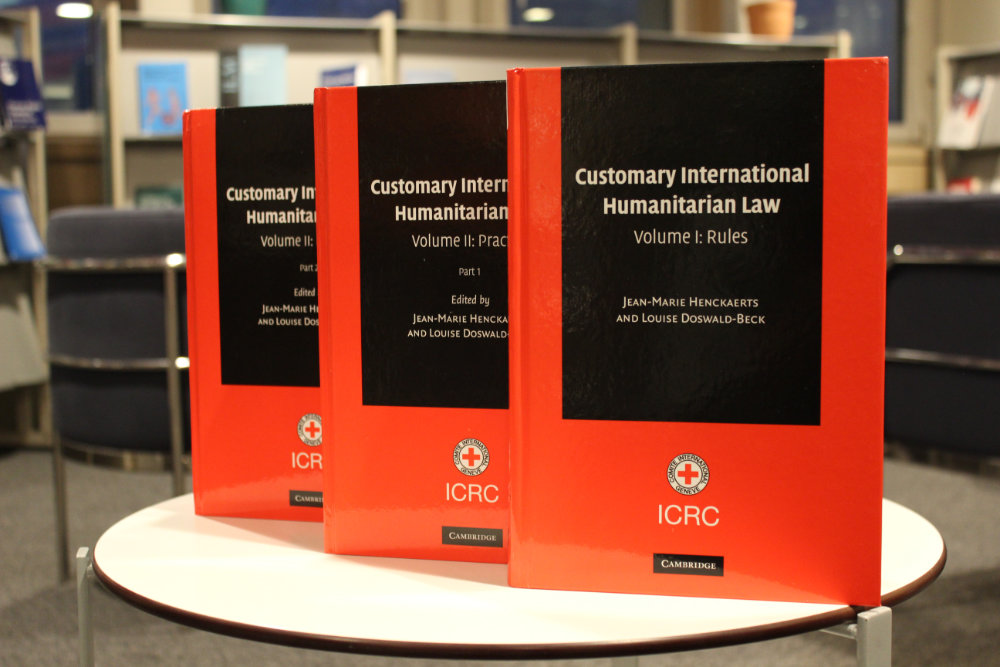On one hand, there are well-meaning yet absolutist framings which lump together the presumed category of ‘men’ and ‘the masculine,’ and the presumed category of ‘women’ and the ‘feminine’ in the name of ‘gender-sensitive’ analysis. On the other – a wry, if unwitting blame-game over whose suffering is masked more (meaning either men or women – both as concrete and homogenous categories). This is not to mention the continued conflation of sex and gender at all junctures in between. So how can the humanitarian sector move beyond binaries and begin to critically engage with systems that both propagate war and how people suffer because of it?
We don’t have the answers. But, we can tell you why we need to find them.
We first do so by examining the take of Gilbert Holleufer, in order to demonstrate how ‘gender’ is differentially (mis)understood. We then examine the system known as heteronormativity in relation to its role within conflict settings and the many manifestations of suffering within it. Finally, we call for an approach to humanitarian action that takes into account how multiple social/identity markers impact the gendered experiences of people who partake in and are affected by armed conflict and other situations of violence.
The so-called ‘masculine condition’
In positing his views on the ‘modern day paradox’ of ‘men and masculinities,’ Holleufer takes a diverging perspective from his fellow thinkers. He does not ask for a humanitarian agenda that is more inclusive of men and the gender norms affiliated with the performance of masculinities, as does Slim. Nor does he consider Duriesmith’s well-supported point that there is “no one ‘masculinity’” but “a multitude of mutually accepted ways to be a man” which differ in time and place. Instead, Holleufer focuses on ‘the masculine condition’ (in the singular), lamenting how men (though never defining which men he means) are forced to engage in the violence that is part and parcel of war, and as a result, suffer.
He claims that while a school of second-wave feminists have brought to centre stage the idea that gender is socially constructed, these very same (unnamed) feminists are ostensibly to blame for societal acceptance that men (as an amorphous category) are intrinsically violent.
According to Holleufer, fault can be found with a “certain kind of ‘politically correct’ mindset, an inheritance itself of post-war human rights and 1970s feminist thinking” for contributing to the obscuring of “the suffering of men in war.” This, he says, is due to their failure to acknowledge that violence is nurtured in men over time, rather than something that comes to them naturally. Has post 1970s feminism (whatever that may mean) really promulgated the idea that masculinity is naturally more violent and thus contributed to a lack of focus on men’s suffering in war? And moreover, what is the elusive ‘masculine condition’?
Who’s afraid of the faceless feminists?
Despite what Holleufer claims, feminists are not pigeonholing masculinity into a “biologically determinist” corner; they are routinely doing exactly the opposite. Building off each other, ‘waves’ of the feminist movement have advanced the fight for the rights of women of all spectres and identities and argued for equity along gender (and other) lines. This has almost invariably entailed looking at where men (as much as they constitute a singular category) fit into the equation.
Feminist scholars of all genders, focusing on masculinities, have thus led the way in mainstreaming understanding that men are adversely impacted on multiple levels when they are expected to live up to ideals relating to their assigned gender.
Holleufer, however, is not our focus in this analysis. Rather, we aim to question all analyses that conform to the bounds of sex and gender binaries. We query whether feminist thought and the way it has been applied to humanitarian practice has gone far enough in unpacking the many systems at play when we talk about masculinities. We argue for a lens that explores the formation of hegemonic masculinities – and their connections to conflict – beyond a focus solely on men and women as singular, diametrical categories. Rather, it should focus on challenging sex and gender categorizations as a whole.
We argue that by relying on heteronormative frameworks, political actors manipulate ideals affiliated with “nationhood” – not just in relation to gender, but to race, class and ability, to name a few. They do so as a means to mobilize the masses necessary to engage in conflicts that would otherwise be unjustifiable. But before going forward, let’s be clear on some key definitions.
What do ‘hegemonic masculinity’ and ‘heteronormativity’ even mean?
Hegemonic masculinity, theorized most notably by R.W. Connell and James W. Messerschmidt, refers to how power dynamics and numerous social factors lead to a hierarchy of masculinities, whereby men can be compared and contrasted based on how they measure up to an unattainable ideal of what it is to be a ‘real man’.
Such understanding of how masculinities take-on toxic dimensions – and their implications for warfare – has led to numerous IOs, NGOs and non-profits launching programmes, reports and policies that are specifically geared toward including ‘men and masculinities’ into the discussion on gender.[1] While this is a welcome progression, the conversation seems to have stalled at consensus that gender means the protection of women and inclusion of men into the dialogue on protection and assistance – with maybe the acronym LGBTI+ (or a variation thereof) thrown in for lip-service.
It falls short however of understanding the limits that a heteronormative framework for analysing gender can impose on understandings of men and masculinities (or dynamics of conflict and response as a whole). So, what is heteronormativity?[2]
‘Heteronormativity’ generally refers to “the Western social norm, or assumption, that the overwhelming majority of sexual relationships in society are heterosexual. Heteronormativity is the dominant sexual model of social, cultural, political, and economic organization,” producing hierarchies of identities and ideologies of gender and sex.[3]
Within this framework, gendered typologies – meaning hegemonic masculinity or idealized femininity – are indicative of norms for gender and sexuality. It is not enough that a man is ‘tough,’ and ‘masculine’. Implicit in this framework is for him to be seen as heterosexual, a ‘ladies’ man’.
Different cultures and geographies have their own versions and value systems of what it is to ‘be a man.’ Across the board, while gender norms may differ the boxes they come in remain the same. In line with Judith Butler’s theory of performativity, we contend that in reality, there is no innate ‘masculine condition’ separate from the gender norms that replicate an illusion of it. Butler seeks to challenge the supposition that ‘the masculine’ and ‘the feminine’ exist as oppositional categories –orbiting in relation and reaction to one another through a defined set of standards and behaviours.
For Butler, there are no ‘men’ or ‘women’. There are only assumed bodies belonging to each, which undertake and replicate assumed ways of acting and interacting (i.e. sexual and romantic attraction to each other and only each other).
These beliefs and corresponding actions get reinforced over time until they appear like the only beliefs and actions possible – creating a system of norms, and corresponding hierarchy which we call heteronormativity.
But why is understanding the gender binary, heteronormativity and its surrounding systems important to our understanding of conflict? While the implications of the gender binary are manifold and clearly go beyond conflict, we will focus on just two manifestations.
How can we see heteronormativity?
Firstly, heteronormativity is one of many systems harnessed in the waging of war. After all, when men fight in war, for whom and for what are they fighting? Hegemonic (especially militarised) manifestations of masculinity rely on the existence of a heterosexual idealized feminine counterpart to be granted legitimacy and acceptance among an otherwise ‘pacifist’ public. Hegemonic masculinities and idealized femininities ‘each keep the other in place.’
Heteronormativity, and the ‘hyper’ femininity and masculinity it engenders, allows for policies of imperialism to be employed in the name of ‘The Nation’ or even of feminism itself; a form of ‘masculinist militarism in drag.’ Look no further than the white female politician who is praised for polices of reproductive rights at the national level – while given a pass for the tolls their policies in pursuit of military interests have on majority persons of colour abroad. Nation States that pursue normal processes of state-building generally have interests in keeping the system of heteronormativity concealed and the limits of ‘acceptable’ sexuality and expression within these confines. There is no better way to reproduce the Nation State – than to reproduce for it, as the argument goes.[4]
Secondly, heteronormativity and its surrounding systems have implications for individuals perceived as living outside of these norms, in that anyone seen to deviate from its parameters can be subject to violent discipline. Putting people in boxes has implications for those who fall out of them, or who were never perceived to fit in at all. So-called ‘corrective rape’ is but one example of a form of violence based on sexual orientation and/or gender identity/expression. This impacts lesbian, bisexual and/or trans women (or other women with non-normative identity) in particular. Such forms of violence become exacerbated in conflict settings and are present at intrapersonal, communal and structural levels of societies. Yet research in this domain is nascent.
The humanitarian as heteronormative
Most conversation (if not all praxis) in humanitarian space is still stuck within a heteronormative configuration of sex and gender. This serves to obscure understanding of systems on which conflict is built and the ways in which certain bodies (including men of many kinds) suffer in distinct ways. Although a limited sample size, only two of the five previous posts on the Law and Policy Blog’s gender series made mention of either the gender binary, the system of heteronormativity or the experiences of sexual and gender minorities, in terms of the many forms of discrimination they face.
Many organisations ‘talk the talk’ in terms ‘intersectionalising’ their approaches and praxes. However, there are often enormous voids – financial, political and even in understanding – when it comes to ‘walking the walk’ or ‘doing’ intersectionality. Even understandings of ‘gender’ as a term (let alone how it is practically applied) are inconsistent. In reality, few organisations demonstrate a practical approach that goes in any way beyond a traditional, predominantly binary approach to gender and sexuality.
Where do we go from here?
We could continue to squabble over whose suffering nameless feminists have obscured the most, whether by chance or design. Or, we could start questioning the systems that are so scrupulously upheld that we no longer see them or the varied ways in which they affect us all.
Scores of activists, individuals, collectives and groups of all kinds have been doing the latter for years, even in the humanitarian sphere, many risking punishment as a result. Examples range from sex workers working to protect other sex-workers in emergency settings; to clinicians making trans-inclusive guides to clinical management of sexual violence; to practitioners who interrogate the in-built (if unintentional) normativity of standard S/GBV programming.
Yes, let’s talk about masculinities and war – just not how Holleufer suggests. Instead, let’s talk about how hegemonic masculinities make their way into militarised structures. How they pervade the realms of intimate partnerships, of all kinds of gender configurations, to be played out in the very violence they valorise. Let’s talk about how forms of imperialism packaged as ‘feminism’ have profited from binary impositions of sex and gender, and are then re-inscribed in humanitarian response. Let’s talk about the complexity of translating theories into praxis; of comprehending complex socio-political realities. Let’s talk about how we can learn from populations for whom simply holding hands could mean persecution and whose bodies are being regulated. Because these are the ways in which we can understand the many pixelated and conflicting microcosms of conflict. Including the suffering of ‘men’ within it. Then let’s not talk – lets listen.
***
Footnotes
[1] See: UNFPA, Men, Masculinities, and Changing Power (2014); UN Women, Understanding Masculinities – IMAGES MENA (2017); Understanding Masculinities and Violence Against Women and Girls (2015); Oak Foundation and Promundo, Masculine norms and violence- making the connections (2018); Care International, Broadening gender: Why masculinities matter (2013); International Alert, Rethinking gender in peacebuilding (2014); Saferworld, Masculinities, conflict and peacebuilding (2014).
[2] While the term was coined by Warner and Seidman in 1991, there is actually no consensus on an “exact” definition for the term, and the definition has morphed over time and across disciplines.
[3] This piece is limited in that it does not explore the connected system known as ‘cis-normativity’: that is the assumption that all individuals have a gender-identity corresponding to the one they were assigned at birth. Similarly, we have not explored how hetero-and cis-normativity intersect with other systems such as racism, ableism and xenophobia.
[4] The authors acknowledge that reproduction and the formation of families are by no means limited to or within nuclear family structures. However, ‘alternative’ family structures are seen to represent a potential displacement of the nuclear model from the cornerstone of society, and thus generally fall beyond the bounds of ‘acceptability’ vis-à-vis preservation of the Nation State.
See also
- Challenging patriarchy: gender equality and humanitarian principles, Ricardo Fal-Dutra Santos, 18 July 2019
- Masculinity and humanitarianism, Graham Parsons, 20 May 2019
- The masculine condition in contemporary warfare, Gilbert Holleufer, 14 May 2019
- Equal treatment for women in State armed forces: Three practical implications for medical care, Helen Durham & Vanessa Murphy, 8 March 2019
- The impact of gender and race bias in AI, Noel Sharkey, 28 August 2018
- Continuing the conversation: Which masculinities, which wars? David Duriesmith, 5 July 2018
- Masculinity and war–let’s talk about it, Hugo Slim, 15 March 2018
***
DISCLAIMER: Posts and discussion on the Humanitarian Law & Policy blog may not be interpreted as positioning the ICRC in any way, nor does the blog’s content amount to formal policy or doctrine, unless specifically indicated.







Thanks for your post. A few comments :
– After reading your post, I still don’t understand the concrete meaning of “intersectionality” in this specific context. I have a different understanding if this concept butmaybe you can specify again a bit more ?
– I see you’re using a lot of the so-called neo-feminism vocabs and concepts that for me doesn’t reflect the reality and, even more important, the real humanitarian needs of women on the ground. I am in this sector for quite a while new, deeply committed to fight violence and discrimination based on gender and sex and interested by feminist literature. If I found many inspirations in historical feminism fights, more universalist, such as the right to vote, salary equality, birth control, etc, I honestly can’t find any meaningful, useful and practical concepts in more recent feminism theories, quite well reflected above.
Therefore, I would be glad to continue the conversation (and change my mind :)) and hear from you about more specific and concrete example where those concepts and frame of analysis could be useful for us in our daily work to support people in need.
Thanks,